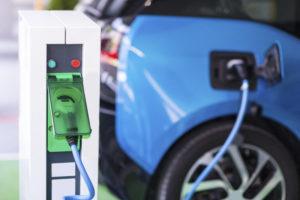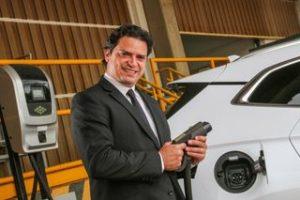(MENAFN- Brazil-Arab News Agency (ANBA))

São Paulo – Ten years ago, 130,000 electric vehicles were sold around the world. Now, this same amount may be sold in just one week. The market share of electric vehicles has increased year after year, and over the past three years, contrary to the trend ushered in by the pandemic, which decreased sales of conventional cars, electric vehicles saw an impressive growth: In 2019, 2.2 million units left the factories, accounting for 2.5% of the market. In 2020, this number climbed to 4.1%, at 3 million vehicles, and last year at 6.6 million electric cars, this share reached 9%. This year's forecasts indicate that it is expected to double and reach 18%. Electric cars promise a more sustainable, cleaner, more technological future and present.

ABVE's Maluf: Growth of electric vehicles
According to a report by the International Energy Agency (IEA), 16 million electric vehicles are estimated to be running around the world, consuming approximately 30 terawatt-hour (TWh) per year, a volume that corresponds to all the energy generated in Ireland. This tends to grow. Saudi Arabia, the world's second leading oil producer, announced in March that it will start its first electrical vehicle factory in the country's capital city. China leads the global growth. In 2021, sales in the Asian giant reached 3.4 million units. This means that last year more electrical cars were sold in China than in the whole world in 2020. This year the country continues to lead, and according to the president of the Brazilian Association of Electrical Vehicle (ABVE), Adalberto Maluf, it is expected to remain at this level for a while.“There is a policy to encourage this commerce in China. The interest rate for buying electrical cars, for example, are half of the one charged for buying a conventional car.” The official goal of the Chinese government is that electrical cars account for 20% of the market by 2025.

Guadalupe: Less polluting option
In Europe, in absolute figures, the largest electrical vehicle market was Germany, where more than one in every three new cars sold from November to December 2021 were electrical. In the United States half a million electrical vehicles were sold last year. One of them was the Ford Mustang Mach-e, with an extended-range battery that offers a 306-mile (490-km) autonomy, bought by Guadalupe Albuquerque (39 years). The Brazilian explains that she chose an electrical vehicle based on the benefits that this type of machine offers:“They are less polluting, the cost for powering it is low, and so is the maintenance; they are silent as they lack the bumps of the engine, and to top it all, the US government gave me back a USD 7,500 credit in taxes.”
In Brazil, even without relevant incentives for individuals or companies, the market still manages to grow but at another pace. According to the IBGE, in 15 years the car fleet went from 45 million in 2006 to 111.4 million last year. The number of electric vehicles on the road is only 90,000 but is expected to surpass 100,000 by August, according to estimates, Maluf says. Year to date through May, 16,354 were sold, up 54% from 10,392 a year ago. In the first four months of the year sales accounted for 2.5% of the entire fleet, the ABVE's president says.“The most sought after are the hybrid ones, at 60% of the market. They are cars with two engines, one conventional and one electric, that operates with a small battery without external recharge, and the so-called Plug-in that can run on electricity or combustion, as needed,” he said.
A market to occupy
Hybrid cars lead because the infrastructure to cater to electric vehicles is still being built in Brazil. The lack of charging points on the roads is a problem for owners of such vehicles as, if they don't plan right, they can come home towed by a winch. This is where GreenV, a startup that develops technology for electric mobility, sees a window of opportunity.“There's an exponential demand in the country, which has one of the world's largest fleets. It is an expressive market for initiatives involving electric vehicles as they are here to stay,” says Junior Miranda, CEO of the company created in 2021 that received a BRL 22 million (USD 4 million) from a US fund to invest in the country. Present in 24 states and with 2,500 charging points already in place, the company aims to significantly expand its presence by 2025.“We have partnership programs with automakers, parking lots and businesses to further expand the charging infrastructure for both slow and semi-fast and fast charging, thus making it possible that more of such vehicles run around the cities and roads.”

GreenV's Junior: Startup in the new market
Junior says there are Brazilian roads with charging points along the way.“This is the case of BR-277 in Paraná, which crosses the state from East to West, and Rodovia Presidente Dutra, that connects São Paulo and Rio de Janeiro. Furthermore, it is increasingly common to find charging stations in gas stations with exclusive areas for electric vehicles,” he said. In a country the size of Brazil, it doesn't seem much. In the US, when she is out of her town, Guadalupe uses an app to find where she can fuel the battery of the car and how much time is needed. According to Maluf, the arrival of 5G in Brazil will provide the Internet with more velocity and less latency, so the experience of driving an electric car will be even better.“The internet of things will make the data transfer smarter and more efficient.”

Green V: Opportunity in charging
Guadalupe lives in Emeryville, a town with a little over 12,000 residents located near San Francisco, California. She estimates that her condominium has around 500 people and 30% of them own electric cars. With such a demand, they have already requested for charging points to be set up in the complex, which will require a small reform. In the meantime, she says there are two options for charging. One is plugging the car in her house outlet and waiting for around five days before using the car. The other, more realistic option is charging it near home in malls, supermarkets, or exclusive points, and waiting half an hour until the car is fully charged. When she is not travelling, she repeats this process every two weeks and spends USD 30 a month.
In Brazil, Maluf says, the charging service in many places is free.“Some enterprises are setting up charging points to offer this extra service to their customers while they are shopping, for example,” she explains. For calculating the cost savings, Maluf makes a simple math:“Every BRL 100 (USD 19) spent in fuel amount to BRL 10 (USD 1.9) in energy.” When the vehicle is recharged at home, there is no significant difference in the light bill, he says. According to Junior,“the increase is fully compensated with the reduction of costs with fossil fuels. The costs are three to five times cheaper.” For having yours“you must install a protection, infrastructure, cabling and energy outlet kit whose costs starts at BRL 3,000 (USD 572). And it is worth, since the driver gains autonomy as they can adapt recharges to their routine, and not the other way around.” Junior gives as reference a model with a battery capacity of 30,2 kWh:“With an energy price at BRL 0.92/kWh, charging the vehicle completely will cost around BRL 27 (USD 5).
In Brazil the premium prices associated with electrical cars is one of the reasons explaining the poor adherence to the new technology.“There are over 70 models available, and almost all of them are luxurious,” Maluf says. The top selling electric car is Toyota Corolla Cross (starting from BRL 158,000 [USD 30,000]), at 5,240 units sold in the first four months of 2022, followed by Toyota Corolla Altis (BRL 390,000 [USD 34,000]) at 2,329 units sold, and Volvo XC60 (BRL 390,000 [USD 74,000]).“The clients that buy electric cars are older, between 40 and 60 years old, with a large purchasing power.” But he stressed that there are niches like businesspeople that adopt green logistics and people worried about avoiding burning oil and CO2 emissions.
Junior believes that expanding vehicle recharging networks in the country will take place in every format – residential, public and private – but he stresses:“Once the legislation is adapted to this expansion.” On March 31, 2021, a law came into force in the city of São Paulo that determines that all commercial and residential building under construction in the city install recharging points for electrical vehicles. The text of the law does not define how many points must be implemented in each unit, only that they have to follow the Brazilian technical standards and that the measurement of the energy cost must be individualized. It is a start.
Small dictionary:
HEV (Hybrid Electric Vehicle) – A type of hybrid vehicle that combines a conventional internal combustion engine system with an electric propulsion unit that does not require external charging. Brazil is the only country to have hybrid flex cars.
PHEV (Plug-in Hybrid Electric Vehicle) – A hybrid electric vehicle whose battery pack can be recharged by plugging a charging cable into an external electric power source like it was a 100% electric car. Its battery pack is usually bigger than the hybrid cars'.
BEV (Battery Electric Vehicle) – A type of electric vehicle that exclusively uses chemical energy stored in rechargeable battery packs.
EV (Electric Vehicle) – An automobile that is propelled by one or more electric motors, using only energy stored in batteries.
*Special report by Paula Medeiros for ANBA
Translated by Guilherme Miranda
The post Brazilian and global consumers seek electric vehicles appeared first on Agência de Notícias Brasil-Árabe .
MENAFN28062022000213011057ID1104448656